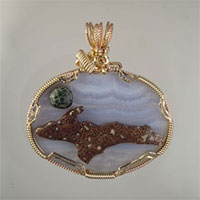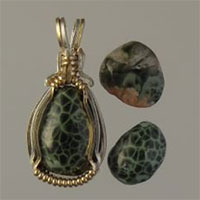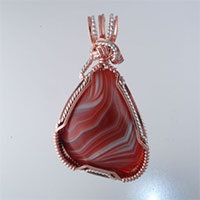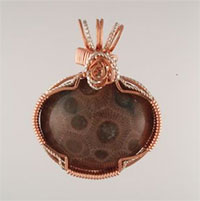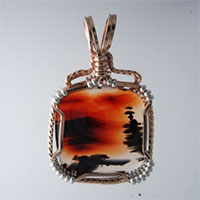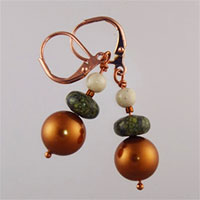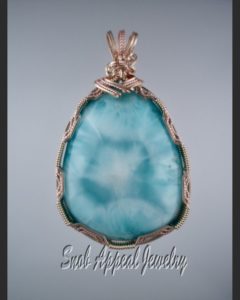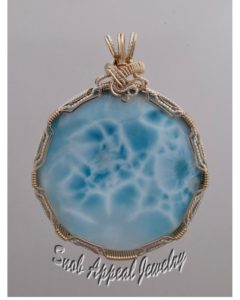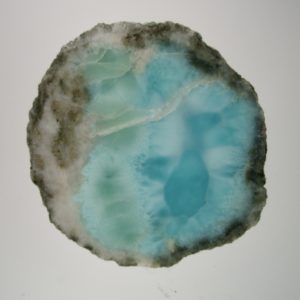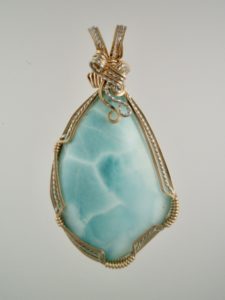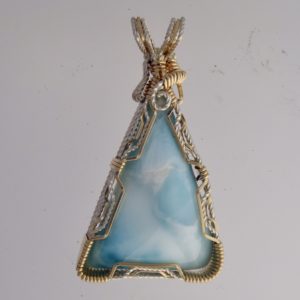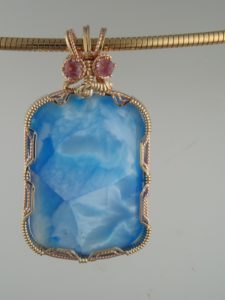Treasures from the Tucson Gem Shows
Some stones offer universal appeal. A gemstone that reminds people of ocean waves crashing up on a sandy beach is hard to ignore. Larimar the beautiful sea-blue stone from the Dominican Republic never fails to attract sighs of delight from shoppers. Our handcrafted Larimar jewelry always tugs on the eyes for attention!
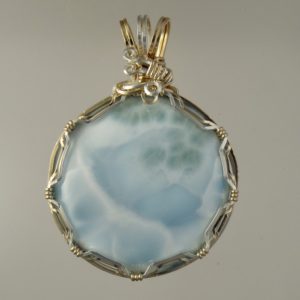
Great quality but a lighter blue than most.
At the Tucson gem shows I seek a small selection of stellar Larimar pieces each year for our jewelry because it is so eye-catching. Customers who appreciate a special quality pendant for their jewelry collections enjoy shopping for these fine stone necklaces. Larimar comes in many qualities. Less choice pieces have washed-out light blue/gray/black patterns containing brownish inclusions or have little or no pattern. It seems every dealer claims to have AAA Larimar in Tucson, but the fact is that less than 3/10 of 1% of all Larimar is the top of the mark. The very best Larimar shines with pastel blue alligator-type patterns across the face. Nice pieces shimmer back at you from cut stone selections and call for your attention!
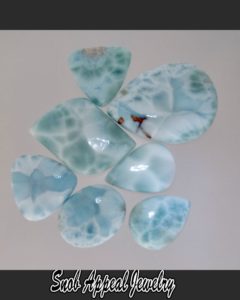
The good stuff; one with copper inclusions. Pictured is not the top of the line Larimar, but nice stuff none the less.
Larimar is only found in the Dominican Republic. It is a form of Pectolite, but the mineral Pectolite is generally soft, not solid for gemstone jewelry making. Larimar is a form of Pectolite with interlocking crystal structure similar to chalcedony making it tougher than other Pectolites. Larimar can range from a hardness of 5 to 7 on Moh’s Scale. The harder the better for making jewelry. Larimar was originally discovered around World War I, and rediscovered by a Peace Corps worker (Norman Rilling) and Miguel Mendez, in the mid 1970’s. Rilling named the stone after his daughter, Larissa, and the French word for the sea, “mer”.
Since then, many holes or mines were dug in the area. I have actually talked to the former owner of the largest Larimar Mine in the DR. She was forced to give up the mine due to the many government regulations for mining it. The work is very intensive as dynamite cannot be used lest the gemstone may be damaged or to avoid mine collapse. . Wet weather makes digging impossible and the mines may be closed 5 months out of the year; the tunnels are prone to collapse.
The best Larimar may be deep within a mine, perhaps a hundred feet or more. Much of the Larimar is not fit for jewelry. As you can imagine, top quality demands premium price both at the wholesale and retail level.
Like Turquoise and Chrysocolla, Larimar gets the blue and green colors from the presence of copper. This year Bonnie grabbed a cabochon that has a visible copper inclusion. Because we sell so many pieces in Michigan’s Copper Country we thought this would be popular there and I look forward to making this unique cabochon into a wire-wrapped pendant. Normally, Larimar with Copper inclusions is considered substandard, but I admire some pieces that have this inclusion.
The closest Gemstones I’ve seen to Larimar is the man-made Victoria Stone and Hemimorphite from China.
The top piece of Larimar this year I purchased on the last day of a show. After looking for two weeks, I finally found just the right treasure, a big bold round beautiful Larimar cabochon. This Larimar gemstone was wire wrapped in pink and yellow gold creating a lush handcrafted pendant, big, bold and beautiful.
Let our Larimar pendants evoke Caribbean beach images for you!


